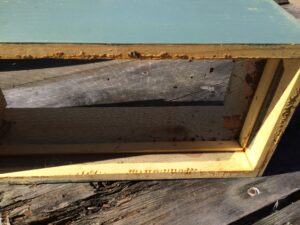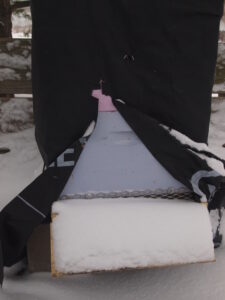My apologies. Yes, it has been too long since I posted a blog.
My excuses? Been working our own hives, a couple dozen others with beekeepers, or for beekeepers (they can’t help it if they ended up in the hospital), AND – posting more on Facebook. FB makes it easier to pop up insights or info. If you aren’t following me there, please check out “Charlotte Hubbard, Beekeeper and …”
Shockingly, it looks like the weather may still allow us to get into the hives here in early November. Wow. But whould you?
Yes—IF weather allows and IF you have a reason. Otherwise, why disturb them?
What’s acceptable weather? Let the bees tell you. If they’re flying—not just one or two but several—you may efficiently go through your hive without too much risk. But a weather general rule of thumb is: above 50, sunny, and light or no wind.
So if this is the last time you get in before next spring, are there things you should be doing? Here are my recommendations. Remember, other beekeepers have other opinions.
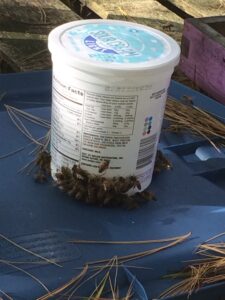
We poked holes in a plastic container full of 2:1 sugar syrup for an inexpensive, somewhat controlled open feeder.
And if you don’t have reason to get in the hive, you can still help your favorite insect by providing 2:1 sugar syrup in an open feed situation. Remember though, it can set off raiding. Make sure you do it FAR from your colonies (like 100 feet), and restrict access to it doesn’t become a mad house. I’ve had some suggestions on my FB page in the last month on ways to do that.
Anyway, here’s our to-do list …
Inside the Hive
Make sure you’re queenright–well, sort of. I always say make sure you’re queenright each and every time you’re in the hive, by finding evidence of the queen. (One egg per cell, and / or worker brood in various stages, or queenie herself when the laying season is over.)
But, you likely can’t do that in early November. Your queen may have already stopped laying for the season–you may not find any eggs or stages of brood. And, it is risky to go through the entire hive searching for the queen (if you accidentally smash her, they can’t recover this time of year.)
Thus, you may want to peek in the brood nest to verify there are no obvious signs that you’re “queen wrong.” We’ve had a couple hives go queenless in the last month. We knew this because of a sign: copious amounts of capped drone brood (and no worker brood) and multiple eggs / cell, along with lots of failed queen cells.
A hive without a queen could make it through the winter, but they can’t raise a new queen (no fertilized egg from which to do so) and cannot build up … and will die between now and next spring with no new worker bees coming online. If you have no queen, contact me and we can discuss options.
Assess their stores. The guidelines for SW Michigan hives is 100-150 pounds of honey to make it through the winter. A full deep frame of honey weighs about 9 pounds; a full shallow about four. Hopefully you made this assessment over a month ago and have been feeding if you’re light. (Feed 2:1 sugar syrup.)
How long do you feed? As long as they’ll take it. However, at some point it’ll get too cold for them to move out of their cluster to travel to a feeder—even an internal feeder.
Reduce the main entrance. To discourage raiding, to hold in heat, to deter critters from entering.
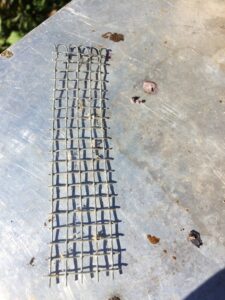
Cut hardware cloth to the size of your opening, and staple it to the hive body for an effective critter-guard that doesn’t hamper bees. This is an example of what we’ll staple in place. Too many bees to remove my gloves to take pics of it stapled in place!
Add critter guards. These are available commercially, or you can make your own easily with carpet tack stripes or hardware cloth. You need to do this before the mice get inside for the winter. Bees won’t chase out the rodents because our little darlings are clustered for warmth, and the rodents will feast on their unguarded pantry. An entrance reducer is NOT mouse-proof—they’ll chew into it to gain access. Or, if you put it on when mice are already in the hive (been there, done that!) they’ll chew their way out.
Consolidate stores over the brood chamber. I told that to a new bee, and he was six shades of confused. Let’s break it down …
Bees are “chimney eaters.” They typically hang out in a lower box, and consume the honey around them. Heat rises, so as they hang out in cluster, the heat they generate softens the honey above them and around them. As the season progresses, they’ll eat that honey and move up, and so on.
We find (repeatedly) that bees often don’t get to frames 1 and 10 in a 10-frame box. The cluster, come winter, isn’t broad enough to soften that honey … or it is so cold that the cluster is tight and doesn’t stretch that far. Thus, if we have two 10-frame boxes with only 16-17 frames of honey, pollen, etc. (the rest of the frames are empty) we center the filled frames over the brood nest (the place where most of the bees are hanging out, typically the middle.) The empty or minimally filled frames are moved to the edges (be it in 10- or 8-frame equipment.)
We have two deeps and at least one shallow on each colony this time of year, and that final top box may only have 5 frames with honey, but hey—it is right above where they’ll probably eat up to come March if they need it. And then, there’s a sugar ceiling (see below) atop that if need … bee.
Remove the queen excluder: You don’t want to keep her from travelling up into boxes as stores are consumed.
Remove extra boxes: If they didn’t draw / fill that top box, they aren’t going to now. They don’t need an attic of empty frames.
Add a sugar ceiling. Hopefully you have 100-150 pounds of honey, but regardless—a sugar ceiling is a fairly cheap insurance should they run out of stores before things are available again. We like the Mountain Camp Method. (Detailed under ‘Publications’ on this site, or google it.) Easy, and about now is the time to do it. Once you do it though, you can’t easily get back into the frames, so it needs to be one of the final things you do as you button up for the season.
And, the sugar piles need a bit of space, so you’ll need a hive body (without frames) to accommodate it. (See below.)
Allow for ventilation: The reason behind this is that bees shiver to generate heat in the winter, which creates moisture. That moisture rises, hits the cold top, condenses, and drips back down upon them. Bees have a harder time surviving being wet and cold rather than just cold. There are a variety of things we do to address this.
First, we have 5/8” upper entrances in 2-3 boxes of each colony to allow for ventilation, and so bees may come out on an unusually balmy winter day to defecate, when their lower entrance might otherwise be covered by snow. These holes are usually on the southern or eastern side of the boxes. We go a bit bigger than other recommendations because we’ve seen bees die in that hole and block it.
Second, when we skirt three sides of the hive (see below), we remove the slider boards and run until spring with screened bottom boards unblocked.
Third, we have a special absorption box—described below.
Allow for absorption: We Mountain Camp every hive, so the newspaper and sugar involved with this will absorb some of that moisture the bees create as they generate heat.
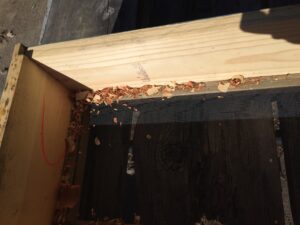
Looking down into our absorption box. More chips are needed, but you can see how the screen is mounted. Note the cutdown of the lengthwise sides at the top.
Because the Mountain Camp Method requires an inch or so of space, we’ve modified a hive body such that window screen is mounted inside it, about two inches from the bottom. This allows us to put a couple inches of cedar shavings in the top half of the box. The chips absorb any moisture that rises that far, keeping it from hitting the top cover, condensing and falling back on the bees.
This modified hive body accommodates the sugar of the Mountain Camp in the bottom half, while securing the important absorption layer on the top half.
Because my husband (God bless him!) has these skills, he also cuts a half inch off the top lengthwise sides of that special box – so air can flow across the top of the box a bit and keep the chips dry. The top cover shelters that minor gap. Alternatively, you could drill some holes above that screen so air can flow across the chips.
Outside the Hive
Skirting: When we think winter is truly, generally here, we will pull the slider boards, and skirt three sides of each colony with house wrap paper and a staple gun that never, ever works right. This keeps prevailing winds from gusting up under the hive. If the colony was light on stores, we may extend that wrap up higher to help them to stay warm.
Add wind blocks: Lawn chairs, junk cars, straw bales—anything to break the wind—that your neighbors will tolerate! J
Check out the surrounding limbs: Any dead limbs that could break off and knock over the hive? Take them out.
Styrofoam insulation: We have a handful of nucs we’re taking into winter. We’re going to bungee-cord ½” sheets of Styrofoam around those, for extra warmth. If you have a weak hive, you may want to do something similar to help them stay warm.

